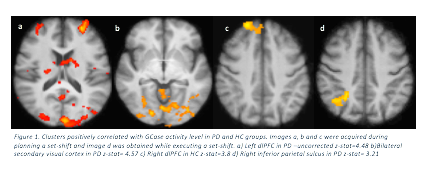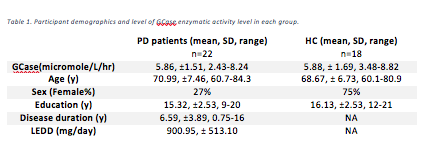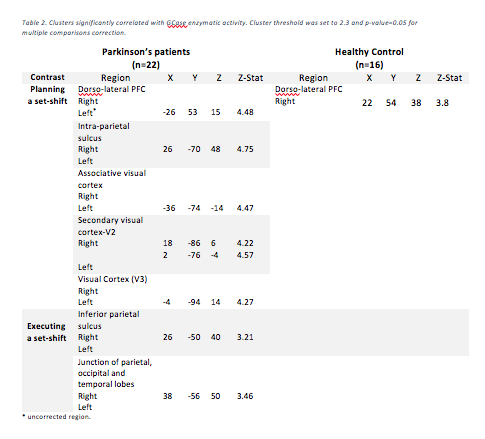Session Information
Date: Monday, October 8, 2018
Session Title: Parkinson's Disease: Cognition
Session Time: 1:15pm-2:45pm
Location: Hall 3FG
Objective: To explore the potential correlation of blood Glucocerebrosidase (GCase) enzymatic activity with fMRI brain activity during Wisconsin Card Sorting Task (WCST), while assessing cognitive and motor loops in Parkinson’s Disease (PD) patients and Healthy Controls (HC).
Background: PD patients with GCase gene (GBA) mutations are more susceptible to visuospatial, memory and executive-function impairments. GCase activity has been shown to be reduced in PD patients’ brain and blood. The possible effect of GCase enzymatic activity level with task-based fMRI has not been explored to date.
Methods: We recruited 22 PD patients (stage 2 or 3 Hoehn and Yahr) and 16 age-matched HC. All participants had a blood draw, and their serum samples were analyzed using the Perkin-Elmer mass spectrometry-based kit. Participants had a full cognitive assessment and 1 hour MRI session in a 3T GE scanner while structural and fMRI data were collected. Enzymatic activity of GCase and neural activity during WCST in each group were analyzed by FSL.
Results: Participants’ demographics and GCase enzymatic activity levels are shown in table1. GCase enzymatic level was positively correlated with average z score of global cognition (r=0.49, p=0.02), executive-function (r= 0.51, p=0.01), language domains (r=0.58, p0.01), Brixton (r= 0.44, p=0.04), and HVOT (r= 0.572, p=0.01) in PD patients. GCase enzymatic activity level was positively correlated with the left dlPFC and the bilateral visual cortex in PD patients while GCase was positively correlated with right dlPFC in HC during planning a set-shift (figure1). Significant clusters are shown in (table2).
Conclusions: GCase enzymatic activity level had a positive correlation with neural activity in frontal and occipito-parietal regions during planning a set-shift and executing it. These findings provide additional evidence on the potential effects of GCase in the modulation of executive-function and visuospatial abilities. GCase might have a more general effect on frontal regions while it specifically correlates with occipito-parietal regions in PD patients. Replication of these results on a larger independent cohort is warranted.
To cite this abstract in AMA style:
M. Ramezani, J.S. Provost, N. Auclair-Ouellet, I. Kathol, A. Hanganu, M. Kibreab, J. Cheetham, T. Hammer, L. Derwent, A. Robichaud, R. Chiang, J. Sarna, SP. Sardi, O. Monchi. Effect of Glucocerebrosidase enzymatic activity on neural activation during a cognitive task in Parkinson’s disease patients [abstract]. Mov Disord. 2018; 33 (suppl 2). https://www.mdsabstracts.org/abstract/effect-of-glucocerebrosidase-enzymatic-activity-on-neural-activation-during-a-cognitive-task-in-parkinsons-disease-patients/. Accessed April 4, 2025.« Back to 2018 International Congress
MDS Abstracts - https://www.mdsabstracts.org/abstract/effect-of-glucocerebrosidase-enzymatic-activity-on-neural-activation-during-a-cognitive-task-in-parkinsons-disease-patients/



